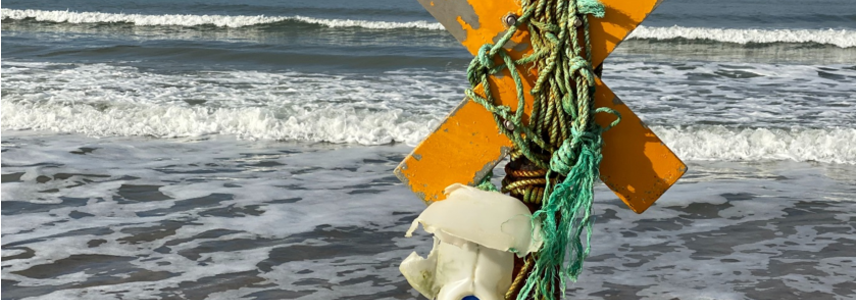Europe is taking action to reduce microplastic pollution

Microplastics are plastic particles smaller than 5mm. They may be tiny, but there are a lot of them in consumer products. More and more often, we find them in nature too. The apparel and textiles industry is a major contributor to the problem. 35% of all microplastic pollution comes from synthetic textiles. The EU is taking the first steps to address the problem with a new restriction on microplastics which could start in 2021.
The European Chemical Agency (ECHA) proposed the new restriction on the intentional use of microplastics in products. This applies to products such as fertiliser, cleaning and laundry products and cosmetics, among others. Microplastics are added to these products to improve viscosity, appearance or stability. The EU member states will likely vote on the new microplastics regulation in 2021. If they approve it, the use of microplastics in many products will be restricted under REACH. REACH is the Registration, Evaluation, Authorisation and Restriction of Chemicals regulation.
This is the first step the EU is taking to reduce the harmful impact of microplastics on nature and people. The impact on the apparel and textiles industry will probably be limited in the short-term. It only applies to microplastics that are intentionally added to consumer products. The new regulation does not apply to products that shed microplastics during use or disposal. Still, the new ban is a sign of growing concern among European policymakers about microplastics.
Where can you find microplastics?
Microplastics are tiny particles smaller than 5mm in length. They are added to products. Sometimes they are released during the use of apparel and textiles made with synthetic fibres, such as polyester, nylon and acrylic. The biggest problem is washing and drying clothes. Richard Thompson is a marine biology professor and the inventor of the term microplastics. He says that an average domestic washing load can release up to 700,000 fibres.
Wastewater filter systems only catch some of these fibres. The smallest fibres make their way into rivers and then the ocean. They are then eaten by fish and eventually end up on consumers’ plates. Researchers estimate that there could be as much as 8 to 14 million tonnes of plastic on the ocean floor. Fibres are the second-most identified shape of microplastics. They account for 35% of all microplastic pollution. In 2018, a third of the fish that Thompson collected from a sample in the English Channel had synthetic fibres in their gut. This number is likely to increase with the use of synthetic fibres.
What is the problem with microplastics?
Scientists are still looking at the long-term effects of microfibres on the health of marine life and consumers. What they do know is that microplastic fibres can absorb and release harmful chemicals into the environment. Recent studies suggest the average person may eat 50,000 microplastic particles every year and breathe in a similar amount. ECHA is very clear about the risks of microplastics. Its director recently stated, “microplastics in products pose a risk to our environment and their use should be restricted.”
What can fashion companies do?
The use of synthetic fibres in apparel is likely to increase in the coming years. Around half of all apparel items are made with polyester. Its use in garments increased from 8,3 to 21,3 million tonnes between 2000-2016. And there is no sign that this number is going down. Shifting to natural fibres can also affect the environment. Producing natural fibres involves water use and pollution, CO2 emissions, land use and chemical use. It is only a good strategy to use natural biodegradable fibres instead of synthetic fibres if they come from a sustainable source.
Producers, brands and retailers can take steps to reduce microplastic shedding in apparel and textiles. The OECD reports that changing the design and manufacture of textiles and garments can decrease shedding rates by up to 80-90%.
Best practices include:
- Lowering temperatures during melt spinning to increase fibre strength;
- Using continuous fibres instead of staple fibres;
- Yarn dying instead of garment dying;
- Coating yarns;
- Avoiding yarns and fabrics that have a high shedding-rate, such as polyester fleece;
- Laser cutting seams; and
- Coating and pre-washing garments.
Producers, buyers and governments should also better inform consumers about ways to reduce fibre shedding during washing and drying. The following best practices reduce fibre shedding:
- Using washing machines at full load and using fabric softeners and liquid detergent;
- Washing at low temperatures; and
- Using a microfibre filter.
To prevent synthetic products from entering the environment and turning into microplastics after use, producers and buyers should encourage proper disposal and recycling. For example, they should encourage using recycled alternatives to virgin synthetic fibres.
The shedding of synthetic fibres is responsible for a large portion of microplastics found in nature. Suppliers should prepare for the possibility that the EU will take measures in the coming years to control this type of pollution. Currently, the EU has not proposed plans to do so. Still, suppliers should consider the prevention measures listed above.
Read more about microplastics, their use, concerns and proposed restrictions on the ECHA website.
Giovanni Beatrice and Frans Tilstra from FT Journalistiek wrote this news article for CBI.
Stay informed
To stay informed on the latest developments in the apparel sector, subscribe to our newsletter.